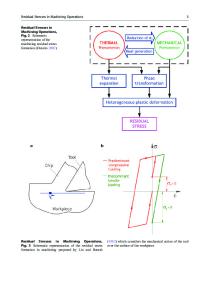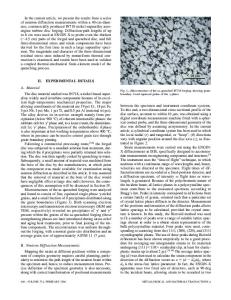Measurements of residual stresses in Al film/silicon nitride substrate microcantilever beam systems
- PDF / 164,656 Bytes
- 6 Pages / 584.957 x 782.986 pts Page_size
- 22 Downloads / 308 Views
Weileun Fang Department of Power Mechanical Engineering, National Tsing Hua University, Hsinchu 30013, Taiwan
Hung-Yi Lin Mechanical and System Research Laboratories, Industrial Technology Research Institute, Chutung, Hsinchu 31040, Taiwan
Chun-Hway Hsueh Department of Materials Science and Engineering, National Taiwan University, Taipei 10619 Taiwan
Sanboh Leea) Department of Materials Science and Engineering, National Tsing Hua University, Hsinchu 30013, Taiwan (Received 25 November 2010; accepted 28 March 2011)
Microcantilevers fabricated by microelectromechanical system processes were used to study the residual stresses in the film/substrate systems. Aluminum films were deposited on silicon nitride substrates by thermal evaporation at room and elevated temperatures, and residual stresses were characterized from the deflection profiles of the Al/SiNx microcantilevers. The Al/SiNx microcantilever beam made of room-temperature-deposited Al film was found to deflect toward the substrate side, which in turn resulted in compressive residual stress in the film. In contrary, the microcantilever of Al film deposited at 105 °C was found to deflect toward the side of Al film when the thickness ratio of film to substrate was greater than 0.31 and the residual film stresses were tensile. The axes with zero bending strain component and zero stresses, i.e., the bending and the neutral axes in the film/substrate system were also investigated. The results can be applied to the arm of the atomic force microscope to characterize its deflection and stresses.
I. INTRODUCTION
The functionality and reliability of film/substrate systems are strongly influenced by residual stresses. These residual stresses can result from many sources, such as the thermal mismatch between the film and substrate,1–3 defects in the films (grain boundaries, dislocations, voids, and impurities) during the film deposition process,4–6 lattice mismatch between two single crystal materials,7 and the surface stress in the film.8 The residual stresses in the film/substrate systems also depend on the materials properties of the constituents and the film deposition process. For example, the residual stresses of the sputtered Al films depend not only on the film thickness but also on the sputtering pressure, substrate bias, and substrate materials.9–11 Different residual stresses may influence the film growth mode and the adatom mobility during different processing stages. Therefore, several theoretical models have been developed to
II. EXPERIMENTAL
a)
Address all correspondence to this author. e-mail: [email protected] DOI: 10.1557/jmr.2011.111
The schematic drawing of the processes to fabricate microcantilevers is shown in Fig. 1. Double-side polished
J. Mater. Res., Vol. 26, No. 10, May 28, 2011
http://journals.cambridge.org
analyze the residual stresses in the film/substrate systems using the mechanical equilibrium conditions.1,12–14 Various techniques have been developed to measure the residual stresses of the film/substrate system.15–22 Among those techniques, the approach
Data Loading...









